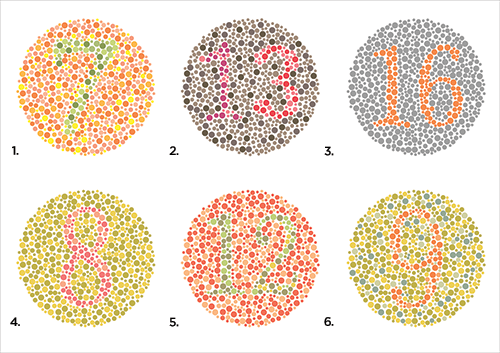The year was 2001 and my ultimate high school crush revealed that he was born color blind. Sitting in the back of that bus headed from Queens to Brooklyn, I vowed that I would find out just enough to understand what color blindness is to make sure he didn’t think that every outfit I wore was some boring shade of brown or grey. Unfortunately, the week following this announcement, my 14 year old self decided another boy was best suited to become my ultimate high school crush…for that week, at least. Consequently, I never really did look into the meaning of color blindness. And as for my husband – well, he made it very clear to me while we were dating that he had a very discerning eye for color. I learned this tidbit one evening when he commented that it was “interesting” that I was wearing brown boots with black leggings. Wasn’t that a fashion faux pas, he inquired? #majoreyeroll
Given that this condition affects approximately 1 in 12 men and 1 in 200 women, I figured it was about time to look into it. First of all, I learned that the term color blindness is a misnomer. It is more of a color deficiency. One who is color “blind” lacks the ability to clearly distinguish between different colors. This limited range of sight gives people trouble with reading certain signs, browsing many websites and taking particular jobs.
What is color blindness and what causes it?
Color Vision Deficiency means that you have trouble seeing red, green or blue or a combination of these colors. It is typically an inherited condition, affecting males more frequently than females. It occurs when light-sensitive cells in the retina do not respond correctly to variations in the wavelengths of light. Color blindness can also result from trauma to the brain, diseases, or other age-related causes.
Inherited color blindness results from mutations on the X chromosome and can start as early as in the womb as well as late into adulthood. The most common form of inherited color blindness is the red-green deficiency. In other words, most people who are color blind do indeed see the world in color. They simply have issues with certain individual colors or color combinations. For instance, something might look green in one situation but not in another. One who has a color vision deficiency might be able to see green but not nearly as saturated of a green as a non-color blind person would see. This difficulty in discernment leads to a number of issues in addition to the ones already mentioned such as shopping for clothing, cars, etc.
How is color blindness diagnosed?
Color Vision Deficiency is typically diagnosed in childhood using simple screening tests such as the Hardy-Rand-Rittler (HRR) and Ishihara Color Plates. These tests are used to determine the type and degree of color deficiency. During these tests, the patient is asked to identify the colored shapes or numbers that lie within a jumble of dots. Based on the patient’s responses, the doctor can then detect and categorize the deficiency.
Can color blindness be treated?
Color blindness, particularly congenital color blindness, cannot be treated but there are ways to work around the “disability.” For instance, apps exist to help with color detection. You can also ask your eye doctor to prescribe special lenses to help enhance color perception. Finally, feel free to enlist the help of friends/family to assist you with organizing your closet by color so that you memorize the placement of your clothing in accurate color groups rather than struggle daily with worrying about clashing or mismatching all your outfits.
Here are some more facts on color blindness to help you look cool at your next dinner party:
- 99% of all colorblind people are not actually color blind. Rather, they are color deficient.
- Someone with normal color vision can tell about 100 colors apart whereas someone with color blindness can only tell about 20 colors apart.
- Despite what you may have heard, dogs are actually not color blind
- If a woman is red-green color blind, then all her sons will be colorblind.
- When using color correcting lenses, you are wearing two different colored lenses in your eyes.
- “What color is this?” is probably the most annoying question you can ask your friend who is color blind.
Test yourself!
There are numbers in each of the below circles. Can you see them? See the answers below.
6. The number 9. 5. The number 12. 4. The number 8. 3. The number 16. 2. The number 13. 1. The number 7.
